Overview
- Brief Narrative
- Small, wooden ornament with a separating eggshell design made by Jiri Lauscher, who was an inmate of Theresienstadt, the German name for Terezin, ghetto-labor camp from December 1942 - May 1945. Jiri's woodworking skill got him assigned to the camp technical department. Jiri was from Prague which Germany invaded in March 1939 and annexed into the Protectorate of Bohemia and Moravia. Due to the Nazi regime's anti-Jewish policies, Jiri was fired from his job. That September, Germany invaded neighboring Poland. In September 1941, Heydrich, SS chief of Reich security, became Reich Protector and soon there were daily deportations of Jews to concentration camps. In July, Jiri's parents, Anna and Julius, were deported, and in September, his brother Frantisek. In December 1942, Jiri, Irma, and daughter Michaela, 5, were sent to Theresienstadt. Jiri became part of a closeknit group of artists at the camp. Irma taught Jewish traditions in the secret classes held for children. In late October 1944, Jiri was waiting for his assigned transport train, when an SS guard asked for men to repair a roof. Jiri volunteered and the train left before the roof was finished. These were the last trains sent to Auschwitz. The camp was taken over by the Red Cross on May 2, 1945. The war ended when Germany surrendered May 7. Jiri and his family returned to Prague in June. Most of their relatives were killed in German concentration camps.
- Date
-
undated:
- Geography
-
creation:
Czechoslovakia
- Credit Line
- United States Holocaust Memorial Museum Collection, Gift of Jiri Lauscher in memory of his wife Irma Lauscher
- Contributor
-
Subject:
Jiří Lauscher
Artist: Jiří Lauscher
Subject: Irma Lauscher
- Biography
-
Jiri Lauscher was born on September 14, 1901, to Jewish parents Siegfried and Anna Schwarz Lauscher near Prague, Austro-Hungary (Czech Republic). His father Siegfried was born in the mid-1800s. His mother Anna was born on August 22, 1876, in Pribram, to Jakob and Leonora Schwarz. Jiri had two siblings: Frantisek, born October 12, 1899, and Josefina, born in 1906. The empire collapsed at the end of World War I (1914-1818) and Prague was part of the newly independent Czechoslovak Republic. Jiri’s father Siegfried died and his mother married Julius Katz, (1874-1942). Jiri was a Zionist and at some point, went to Palestine and lived there for a while before returning to Prague. Jiri, an artisan and designer, was the technical director of a fur factory. He married Irma Kohn, born May 2, 1904, to Ruzena Kohn. Irma was a dedicated teacher and graduate of Charles University where she studied German. She taught children at the Jewish School in Prague. Jiri and Irma’s daughter, Michaela, was born on December 30, 1936.
On September 29, 1938, Nazi Germany annexed the Sudetenland border region of Czechoslovakia. On March 15, 1939, Germany annexed the Czech provinces of Bohemia and Moravia, where Prague was located, ruled by a Reich Protector. Other regions were absorbed by German allies and Czechoslovakia ceased to exist. Jews were banned from most professions and organizations. Jiri was fired from his factory directorship. He was a talented woodworker and got a job in a carpenter’s workshop, which made toys and other crafts. Jewish children were expelled from public schools and Irma worked two shifts at the now very overcrowded Jewish School. Jewish life was restricted. There were curfews, few shops would serve Jews, and Jews could shop only a few hours a day. Jiri and his family were kicked out of their apartment so a German officer could live there. They had to move to an old house shared with three other families; each family allotted only a single room. Radios and all valuable possessions were confiscated.
On September 1, 1939, Germany invaded neighboring Poland. In September 1941, Czech Jews were required to wear a yellow Star of David badge to make them easy to identify. At the end of the month, Reinhard Heydrich, SS Chief of Security for the Reich, became Reich Protector. Regular deportations of Jews from Prague began, with daily transport notices in the newspapers. On July 16, 1942, Jiri’s mother and stepfather, Anna and Julius, were deported. The Jewish School where Irma worked was closed. On September 8, Jiri’s brother Frantizek was sent away. On December 22, Jiri, Irma, and Michaela were sent on transport CK to Theresienstadt ghetto-labor camp, 40 miles north of Prague. When they arrived Jiri was asked his profession. He showed them a wooden toy which Michaela had brought that he had made at work and they were sent onto the camp. The family was separated, as men, women, and children were housed in different barracks. Jiri was assigned as a draftsman in the camp technical department. He became part of a closeknit group of other artists, including Dr. Karel Fleishmann, Peter Kien, Bedrich Fritta, Karel Bruml, and Leo Haas. Michaela contracted typhus, scarlet fever, and measles, and was placed in the infectious disease ward at the hospital. One of Jiri and Irma’s cousins, Hana Mueller Schiff (later Bruml), was a nurse and cared for her and brought Jiri and Irma notes and drawings from Michaela, as they were not permitted to visit. After Michaela recovered, she was able to live with her mother. Irma was involved in the clandestine classes offered for children and taught them about Jewish traditions. In January 1943, Irma bribed a camp guard to smuggle her a tree sapling. She needed the young tree to celebrate Tu B'Shevat, the New Year for Trees, with the children. She planned a secret ceremony with dancing and singing with the children and together they planted the tree, using their precious water rations to nurture it. Other children continued to care for the tree they called Etz-Hayim, the Tree of Life, and as it grew it was a symbol that life goes on. It was difficult to get paper and pencils, and Irma would sometimes trade her scarce bread for supplies. Over 90% of the children in Theresienstadt did not survive the Holocaust. In fall 1944, there were frequent, large transports taking inmates to camps in the east. Around October 1944, Jiri was scheduled for deportation. Irma wanted to volunteer that she and Michaela go with them, but Jiri insisted she not do so, and she complied. While Jiri and the other deportees were waiting for the train to arrive, an SS commander came to get workers to repair a roof recently damaged in a windstorm. Jiri and a few others volunteered to do the work and the train departed while they were still working. There were few transports after that and Jiri remained in Terezin.
By early 1945, all of Jiri’s close friends were deported to other camps, primarily Auschwitz, and as the last member of the group, he became the guardian of their personal possessions. The International Red Cross took over the camp on May 2, 1945. The guards fled, and on May 9, the Soviet Army entered the camp and took control. The war had ended on May 7 with Germany’s surrender. The Jewish Council archive was burned, but Jiri preserved as much material as he could and photographed the camp, in order to document what had occurred there. In June, after three weeks under quarantine, the family returned to Prague. They learned that most family members had not survived. Jiri’s mother Anna and stepfather Julius were murdered in Treblinka killing center on October 19, 1942. His sister Josefina and her husband Arnost Saar were sent to Theresienstadt on January 23, 1943, and then to Auschwitz 8 days later and murdered in the gas chambers upon arrival. His brother Frantisek was deported to Auschwitz on February 2, 1943, and killed upon arrival. Jiri and Irma’s cousin Hana Schiff wrote to let them know that she was still alive and had returned to Prague, which was a great surprise, as Irma had been told by an acquaintance that they saw Hana killed in a concentration camp.
As antisemitism emerged in postwar Soviet controlled Prague, Jiri and his family tried to emigrate to Israel in 1951. They were refused permission and the family attempted to leave illegally. They were caught at the border and jailed, Jiri for two years. Michaela was expelled from high school. She later passed exams for university, earned a doctorate, and had a career as biochemist. She married, and changed her name to Vidlakova, and had a son. Jiri was a sought after expert on Theresienstadt, due to his personal experience and his extensive archive, and led tours of the site into his 80s. The tree sapling that Irma and the children planted was relocated and became a site of memorial and remembrance. Irma and Michaela also shared the stories of their experiences. Irma, 81, passed away in 1985. Jiri, 88, died in November 1989 in Prague.
Irma Kohn (later Lauscherova) was born on May 2, 1904, in Prague, Austro-Hungary, (now Czech Republic). Her mother was Ruzena Kohn. She attended Charles University where she studied German. She became a teacher and taught young children for many years at the Jewish School in Prague. She married Jiri Lauscher, a factory director, and they had a daughter Michaela on December 30, 1936.
In late September 29, 1938, Germany annexed the Sudetenland border region of Czechoslovakia. On March 15, 1939, Germany invaded and absorbed the Czech provinces of Bohemia and Moravia, where Prague was located, which were ruled by a Reich Protector. Other regions were absorbed by German allies and Czechoslovakia ceased to exist. Jews were soon banned from most professions and organizations. Jiri lost his job as a factory director, but later found a job in a workshop that made wooden toys. September 1, 1939, Germany invaded the neighboring country of Poland. In September 1941, Reinhard Heydrich, Chief of the SS, became Reich Protector. Czech Jews were required to wear a yellow Star of David badge to separate them from other residents. Regular deportations of Jews from Prague began, and transport notices were printed daily in the newspapers. On July 16, 1942, Irma’s mother and stepfather-in-law, Anna and Julius, were sent away, and on September 8, her brother-in-law Franz. On December 22, Jiri, Irma, and 5 year old Michaela were transported to Theresienstadt ghetto-labor camp, about 40 miles north of Prague. The overcrowding and poor sanitary conditions of the camp caused disease to spread very quickly. Shortly after their arrival, Michaela contracted typhus and scarlet fever and was placed in the infectious disease ward at the hospital. One of Jiri and Irma’s cousins, Hana Mueller Schiff (later Bruml), was a nurse in that ward. Jiri and Irma were not permitted to visit, and Hana would iron drawings and notes made by Michaela to sterilize them and bring them to her parents. Michaela eventually recovered. Jiri was assigned as a draftsman in the camp’s technical department where he worked with a closeknit group of artists. Irma was a devoted organizer and teacher of the clandestine classes offered for children, working closely with Rabbi Leo Baeck. Irma was regarded as the soul of the program for her devotion to the children. She would sometimes trade her scarce bread for school supplies. Irma taught the children about Jewish holidays and traditions. In January 1943, as part of her efforts to keep Jewish culture alive, Irma bribed and persuaded a camp guard to smuggle her a tree sapling. She needed the young tree to celebrate Tu B'Shevat, the New Year for Trees, with the children. She planned a secret ceremony with dancing and singing with the children and together they planted the tree, using their precious water rations to nurture it. Other children continued to care for the tree, celebrating it in poetry and pictures. They called it Etz-Hayim, the Tree of Life.
The International Red Cross took over administration of the camp on May 2, 1945. The guards fled, and on May 9, the Soviet Army entered the camp and took control. The war had ended on May 7 with Germany’s surrender. The family returned to Prague. They learned that many family members had not survived. Jiri’s mother Anna and stepfather Julius were murdered in Treblinka killing center on October 19, 1942. His sister Josefina and her husband Arnost Saar (b. 1901), had been transported to Theresienstadt on January 23, 1943, and deported to Auschwitz concentration camp 8 days later and killed upon arrival. His brother Franz was deported to Auschwitz on February 2, 1943, and killed upon arrival. Jiri and Irma’s cousin Hana Schiff wrote to let them know that she was still alive and had returned to Prague, which was a great surprise, as Irma had been told by an acquaintance that they saw Hana killed in a concentration camp. Only about 150 of the 15,000 children imprisoned in Theresienstadt survived. The tree survived. It was transplanted to the Terezin Cemetery near the crematorium. A headstone inscribed with a poem about the tree was erected nearby. The tree grew to be sixty feet tall. It was a frequent site for ceremonies of remembrance and seeds from this tree were transplanted around the world. The tree died in 2004 due to historic flooding in Terezin. Jiri became a sought after expert on Theresienstadt, and led tours of the site into his 80s. Michaela received a medical degree and became a doctor. Irma, 81, passed away in 1985. Jiri, 88, died in November 1989 in Prague.
Physical Details
- Classification
-
Decorative Arts
- Category
-
Woodwork
- Object Type
-
Wooden novelties (lcsh)
- Physical Description
- Small, finely sanded, varnished, light golden brown, wooden rectangle with rounded bottom corners and a cut out rectangular tab at the top. It has a burned design of a separated eggshell with jagged inner ends in the center of a 6 point Star of David. The front, side, and back edges have burned, dark brown stippling by the electric needle.
- Dimensions
- overall: Height: 1.500 inches (3.81 cm) | Width: 1.000 inches (2.54 cm) | Depth: 0.125 inches (0.318 cm)
- Materials
- overall : wood, varnish
Rights & Restrictions
- Conditions on Access
- No restrictions on access
- Conditions on Use
- No restrictions on use
Keywords & Subjects
- Topical Term
- Concentration camp inmates--Czech Republic--Terezín (Ustecky kraj)--Biography. Concentration camp inmates as artists--Czech Republic--Terezín (Ustecky kraj)--Biography. Holocaust survivors--Czech Republic--Prague--Biography. Holocaust, Jewish (1939-1945)--Czech Republic--Personal narratives. Jews--Czech Republic--Prague--Biography. Woodworkers--Czech Republic--Biography. World War, 1939-1945--Prisoners and prisons, German.
Administrative Notes
- Legal Status
- Permanent Collection
- Provenance
- The wooden ornament was donated to the United States Holocaust Memorial Museum in 1989 by Jiri Lauscher.
- Funding Note
- The cataloging of this artifact has been supported by a grant from the Conference on Jewish Material Claims Against Germany.
- Record last modified:
- 2022-07-28 18:21:13
- This page:
- https://collections.ushmm.org/search/catalog/irn1266
Download & Licensing
In-Person Research
- By Appointment
- Request 21 Days in Advance of Visit
- Plan a Research Visit
- Request to See This Object
Contact Us
Also in Jiri Lauscher collection
The collection consists of small wooden pendants and plaques, a cut metal brooch, and a cut metal pendant relating to the experiences of Jiri Lauscher in Prague, Czechoslovakia, before, during, and after the Holocaust, and in Theresienstadt ghetto-labor camp during the Holocaust.
Date: 1941-approximately 1975
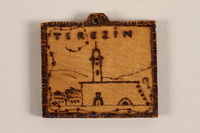
Small wooden tile with the Terezin church steeple made by a former Jewish Czech concentration camp inmate
Object
Small wooden ornament with a view of the Terezin church steeple made by Jiri Lauscher, who was an inmate of Theresienstadt, the German name for Terezin, ghetto-labor camp from December 1942 - May 1945. Jiri's woodworking skill got him assigned to the camp technical department. Jiri was from Prague which Germany invaded in March 1939 and annexed into the Protectorate of Bohemia and Moravia. Due to the Nazi regime's anti-Jewish policies, Jiri was fired from his job. That September, Germany invaded neighboring Poland. In September 1941, Heydrich, SS chief of Reich security, became Reich Protector and soon there were daily deportations of Jews to concentration camps. In July, Jiri's parents, Anna and Julius, were deported, and in September, his brother Frantisek. In December 1942, Jiri, Irma, and daughter Michaela, 5, were sent to Theresienstadt. Jiri became part of a closeknit group of artists at the camp. Irma taught Jewish traditions in the secret classes held for children. In late October 1944, Jiri was waiting for his assigned transport train, when an SS guard asked for men to repair a roof. Jiri volunteered and the train left before the roof was finished. These were the last trains sent to Auschwitz. The camp was taken over by the Red Cross on May 2, 1945. The war ended when Germany surrendered May 7. Jiri and his family returned to Prague in June. Most of their relatives were killed in German concentration camps.
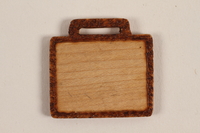
Small blank wooden tile made by a former Jewish Czech concentration camp inmate
Object
Small blank wooden ornament made by Jiri Lauscher, who was an inmate of Theresienstadt, the German name for Terezin, ghetto-labor camp from December 1942 - May 1945. Jiri's woodworking skill got him assigned to the camp technical department. Jiri was from Prague which Germany invaded in March 1939 and annexed into the Protectorate of Bohemia and Moravia. Due to the Nazi regime's anti-Jewish policies, Jiri was fired from his job. That September, Germany invaded neighboring Poland. In September 1941, Heydrich, SS chief of Reich security, became Reich Protector and soon there were daily deportations of Jews to concentration camps. In July, Jiri's parents, Anna and Julius, were deported, and in September, his brother Frantisek. In December 1942, Jiri, Irma, and daughter Michaela, 5, were sent to Theresienstadt. Jiri became part of a closeknit group of artists at the camp. Irma taught Jewish traditions in the secret classes held for children. In late October 1944, Jiri was waiting for his assigned transport train, when an SS guard asked for men to repair a roof. Jiri volunteered and the train left before the roof was finished. These were the last trains sent to Auschwitz. The camp was taken over by the Red Cross on May 2, 1945. The war ended when Germany surrendered May 7. Jiri and his family returned to Prague in June. Most of their relatives were killed in German concentration camps.
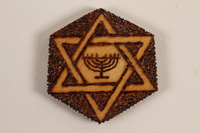
Small hexagonal wooden tile with a Star of David and menorah made by a former Jewish Czech inmate
Object
Small, 6 sided, wooden ornament with a Star of David and an 8 branched menorah made by Jiri Lauscher, who was an inmate of Theresienstadt, the German name for Terezin, ghetto-labor camp from December 1942 - May 1945. Jiri's woodworking skill got him assigned to the camp technical department. Jiri was from Prague which Germany invaded in March 1939 and annexed into the Protectorate of Bohemia and Moravia. Due to the Nazi regime's anti-Jewish policies, Jiri was fired from his job. That September, Germany invaded neighboring Poland. In September 1941, Heydrich, SS chief of Reich security, became Reich Protector and soon there were daily deportations of Jews to concentration camps. In July, Jiri's parents, Anna and Julius, were deported, and in September, his brother Frantisek. In December 1942, Jiri, Irma, and daughter Michaela, 5, were sent to Theresienstadt. Jiri became part of a closeknit group of artists at the camp. Irma taught Jewish traditions in the secret classes held for children. In late October 1944, Jiri was waiting for his assigned transport train, when an SS guard asked for men to repair a roof. Jiri volunteered and the train left before the roof was finished. These were the last trains sent to Auschwitz. The camp was taken over by the Red Cross on May 2, 1945. The war ended when Germany surrendered May 7. Jiri and his family returned to Prague in June. Most of their relatives were killed in German concentration camps.
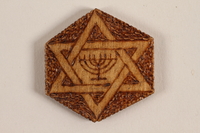
Small hexagonal, wooden tile with a Star of David and menorah made by a former Jewish Czech inmate
Object
Small, 6 sided, wooden ornament with a Star of David and 8 branched menorah made by Jiri Lauscher, who was an inmate of Theresienstadt, the German name for Terezin, ghetto-labor camp from December 1942 - May 1945. Jiri's woodworking skill got him assigned to the camp technical department. Jiri was from Prague which Germany invaded in March 1939 and annexed into the Protectorate of Bohemia and Moravia. Due to the Nazi regime's anti-Jewish policies, Jiri was fired from his job. That September, Germany invaded neighboring Poland. In September 1941, Heydrich, SS chief of Reich security, became Reich Protector and soon there were daily deportations of Jews to concentration camps. In July, Jiri's parents, Anna and Julius, were deported, and in September, his brother Frantisek. In December 1942, Jiri, Irma, and daughter Michaela, 5, were sent to Theresienstadt. Jiri became part of a closeknit group of artists at the camp. Irma taught Jewish traditions in the secret classes held for children. In late October 1944, Jiri was waiting for his assigned transport train, when an SS guard asked for men to repair a roof. Jiri volunteered and the train left before the roof was finished. These were the last trains sent to Auschwitz. The camp was taken over by the Red Cross on May 2, 1945. The war ended when Germany surrendered May 7. Jiri and his family returned to Prague in June. Most of their relatives were killed in German concentration camps.
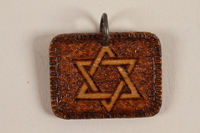
Small wooden pendant with a Star of David made by a former Jewish Czech concentration camp inmate
Object
Wooden pendant with a Star of David made by Jiri Lauscher, who was an inmate of Theresienstadt, the German name for Terezin, ghetto-labor camp from December 1942 - May 1945. Jiri's woodworking skill got him assigned to the camp technical department. Jiri was from Prague which Germany invaded in March 1939 and annexed into the Protectorate of Bohemia and Moravia. Due to the Nazi regime's anti-Jewish policies, Jiri was fired from his job. That September, Germany invaded neighboring Poland. In September 1941, Heydrich, SS chief of Reich security, became Reich Protector and soon there were daily deportations of Jews to concentration camps. In July, Jiri's parents, Anna and Julius, were deported, and in September, his brother Frantisek. In December 1942, Jiri, Irma, and daughter Michaela, 5, were sent to Theresienstadt. Jiri became part of a closeknit group of artists at the camp. Irma taught Jewish traditions in the secret classes held for children. In late October 1944, Jiri was waiting for his assigned transport train, when an SS guard asked for men to repair a roof. Jiri volunteered and the train left before the roof was finished. These were the last trains sent to Auschwitz. The camp was taken over by the Red Cross on May 2, 1945. The war ended when Germany surrendered May 7. Jiri and his family returned to Prague in June. Most of their relatives were killed in German concentration camps.
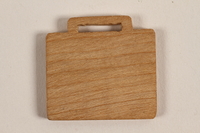
Small blank wooden tile made by a former Jewish Czech concentration camp inmate
Object
Small, blank wooden ornament made by Jiri Lauscher, who was an inmate of Theresienstadt, the German name for Terezin, ghetto-labor camp from December 1942 - May 1945. Jiri's woodworking skill got him assigned to the camp technical department. Jiri was from Prague which Germany invaded in March 1939 and annexed into the Protectorate of Bohemia and Moravia. Due to the Nazi regime's anti-Jewish policies, Jiri was fired from his job. That September, Germany invaded neighboring Poland. In September 1941, Heydrich, SS chief of Reich security, became Reich Protector and soon there were daily deportations of Jews to concentration camps. In July, Jiri's parents, Anna and Julius, were deported, and in September, his brother Frantisek. In December 1942, Jiri, Irma, and daughter Michaela, 5, were sent to Theresienstadt. Jiri became part of a closeknit group of artists at the camp. Irma taught Jewish traditions in the secret classes held for children. In late October 1944, Jiri was waiting for his assigned transport train, when an SS guard asked for men to repair a roof. Jiri volunteered and the train left before the roof was finished. These were the last trains sent to Auschwitz. The camp was taken over by the Red Cross on May 2, 1945. The war ended when Germany surrendered May 7. Jiri and his family returned to Prague in June. Most of their relatives were killed in German concentration camps.
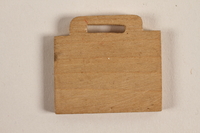
Small blank wooden tile made by a former Jewish Czech concentration camp inmate
Object
Small, blank wooden ornament made by Jiri Lauscher, who was an inmate of Theresienstadt, the German name for Terezin, ghetto-labor camp from December 1942 - May 1945. Jiri's woodworking skill got him assigned to the camp technical department. Jiri was from Prague which Germany invaded in March 1939 and annexed into the Protectorate of Bohemia and Moravia. Due to the Nazi regime's anti-Jewish policies, Jiri was fired from his job. That September, Germany invaded neighboring Poland. In September 1941, Heydrich, SS chief of Reich security, became Reich Protector and soon there were daily deportations of Jews to concentration camps. In July, Jiri's parents, Anna and Julius, were deported, and in September, his brother Frantisek. In December 1942, Jiri, Irma, and daughter Michaela, 5, were sent to Theresienstadt. Jiri became part of a closeknit group of artists at the camp. Irma taught Jewish traditions in the secret classes held for children. In late October 1944, Jiri was waiting for his assigned transport train, when an SS guard asked for men to repair a roof. Jiri volunteered and the train left before the roof was finished. These were the last trains sent to Auschwitz. The camp was taken over by the Red Cross on May 2, 1945. The war ended when Germany surrendered May 7. Jiri and his family returned to Prague in June. Most of their relatives were killed in German concentration camps.
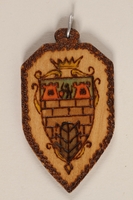
Small colored wooden pendant with Terezin crest made by a former Jewish Czech concentration camp inmate
Object
Colorful wooden ornament with the Terezin coat of arms made by Jiri Lauscher, who was an inmate of Theresienstadt, the German name for Terezin, ghetto-labor camp from December 1942 - May 1945. Jiri's woodworking skill got him assigned to the camp technical department. Jiri was from Prague which Germany invaded in March 1939 and annexed into the Protectorate of Bohemia and Moravia. Due to the Nazi regime's anti-Jewish policies, Jiri was fired from his job. That September, Germany invaded neighboring Poland. In September 1941, Heydrich, SS chief of Reich security, became Reich Protector and soon there were daily deportations of Jews to concentration camps. In July, Jiri's parents, Anna and Julius, were deported, and in September, his brother Frantisek. In December 1942, Jiri, Irma, and daughter Michaela, 5, were sent to Theresienstadt. Jiri became part of a closeknit group of artists at the camp. Irma taught Jewish traditions in the secret classes held for children. In late October 1944, Jiri was waiting for his assigned transport train, when an SS guard asked for men to repair a roof. Jiri volunteered and the train left before the roof was finished. These were the last trains sent to Auschwitz. The camp was taken over by the Red Cross on May 2, 1945. The war ended when Germany surrendered May 7. Jiri and his family returned to Prague in June. Most of their relatives were killed in German concentration camps.

Small wooden shield with a Terezin crest made by a former Jewish Czech concentration camp inmate
Object
Small, wooden tile with the Terezin coat of arms made by Jiri Lauscher, who was an inmate of Theresienstadt, the German name for Terezin, ghetto-labor camp from December 1942 - May 1945. Jiri's woodworking skill got him assigned to the camp technical department. Jiri was from Prague which Germany invaded in March 1939 and annexed into the Protectorate of Bohemia and Moravia. Due to the Nazi regime's anti-Jewish policies, Jiri was fired from his job. That September, Germany invaded neighboring Poland. In September 1941, Heydrich, SS chief of Reich security, became Reich Protector and soon there were daily deportations of Jews to concentration camps. In July, Jiri's parents, Anna and Julius, were deported, and in September, his brother Frantisek. In December 1942, Jiri, Irma, and daughter Michaela, 5, were sent to Theresienstadt. Jiri became part of a closeknit group of artists at the camp. Irma taught Jewish traditions in the secret classes held for children. In late October 1944, Jiri was waiting for his assigned transport train, when an SS guard asked for men to repair a roof. Jiri volunteered and the train left before the roof was finished. These were the last trains sent to Auschwitz. The camp was taken over by the Red Cross on May 2, 1945. The war ended when Germany surrendered May 7. Jiri and his family returned to Prague in June. Most of their relatives were killed in German concentration camps.
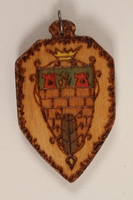
Small colored wooden pendant with the Terezin crest made by a former Jewish Czech concentration camp inmate
Object
Colorful wooden shield shaped ornament etched with the Terezin coat of arms made by Jiri Lauscher, who was an inmate of Theresienstadt, the German name for Terezin, ghetto-labor camp from December 1942 - May 1945. Jiri's woodworking skill got him assigned to the camp technical department. Jiri was from Prague which was invaded in March 1939 by Germany and made part of the Protectorate of Bohemia and Moravia. Under the Nazi regime, Jiri was fired from his job because he was Jewish. That September, Germany invaded neighboring Poland. In September 1941, Heydrich, the SS chief of Reich security, became Reich Protector and soon there were almost daily deportations of Jews to concentration camps. In July, Jiri's parents, Anna and Julius, were deported, and in September, his brother Frantisek. In December 1942, Jiri, Irma, and daughter Michaela, 5, were sent to Theresienstadt. Jiri became part of a closeknit group of artists at the camp. Irma taught Jewish traditions in the secret classes held for children. Around late October 1944, Jiri was waiting for the transport train to Auschwitz, when an SS guard asked for men to repair a roof. Jiri volunteered and the train left before the roof was finished. The camp was taken over by the Red Cross on May 2, 1945. The war ended when Germany surrendered May 7. Jiri and his family returned to Prague in June. Most of their relatives were killed in German concentration camps.

Small wooden tile with the Terezin church steeple made by a former Jewish Czech concentration camp inmate
Object
Small wooden ornament with a view of the Terezin church steeple made by Jiri Lauscher, who was an inmate of Theresienstadt, the German name for Terezin, ghetto-labor camp from December 1942 - May 1945. Jiri's woodworking skill got him assigned to the camp technical department. Jiri was from Prague which Germany invaded in March 1939 and annexed into the Protectorate of Bohemia and Moravia. Due to the Nazi regime's anti-Jewish policies, Jiri was fired from his job. That September, Germany invaded neighboring Poland. In September 1941, Heydrich, SS chief of Reich security, became Reich Protector and soon there were daily deportations of Jews to concentration camps. In July, Jiri's parents, Anna and Julius, were deported, and in September, his brother Frantisek. In December 1942, Jiri, Irma, and daughter Michaela, 5, were sent to Theresienstadt. Jiri became part of a closeknit group of artists at the camp. Irma taught Jewish traditions in the secret classes held for children. In late October 1944, Jiri was waiting for his assigned transport train, when an SS guard asked for men to repair a roof. Jiri volunteered and the train left before the roof was finished. These were the last trains sent to Auschwitz. The camp was taken over by the Red Cross on May 2, 1945. The war ended when Germany surrendered May 7. Jiri and his family returned to Prague in June. Most of their relatives were killed in German concentration camps.

Small wooden ornament with on outline of a town made by a former Jewish Czech concentration camp inmate
Object
Small, wooden tile with a outlined, distant view of the town Terezin made by Jiri Lauscher, who was an inmate of Theresienstadt, the German name for Terezin, ghetto-labor camp from December 1942 - May 1945. Jiri's woodworking skill got him assigned to the camp technical department. Jiri was from Prague which Germany invaded in March 1939 and annexed into the Protectorate of Bohemia and Moravia. Due to the Nazi regime's anti-Jewish policies, Jiri was fired from his job. That September, Germany invaded neighboring Poland. In September 1941, Heydrich, SS chief of Reich security, became Reich Protector and soon there were daily deportations of Jews to concentration camps. In July, Jiri's parents, Anna and Julius, were deported, and in September, his brother Frantisek. In December 1942, Jiri, Irma, and daughter Michaela, 5, were sent to Theresienstadt. Jiri became part of a closeknit group of artists at the camp. Irma taught Jewish traditions in the secret classes held for children. In late October 1944, Jiri was waiting for his assigned transport train, when an SS guard asked for men to repair a roof. Jiri volunteered and the train left before the roof was finished. These were the last trains sent to Auschwitz. The camp was taken over by the Red Cross on May 2, 1945. The war ended when Germany surrendered May 7. Jiri and his family returned to Prague in June. Most of their relatives were killed in German concentration camps.
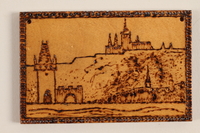
Small wooden ornament with a view of a hillside town made by a former Jewish Czech concentration camp inmate
Object
Small wooden tile with a view of a town and a castle on a hilltop, possibly Prague, made by Jiri Lauscher, who was an inmate of Theresienstadt, the German name for Terezin, ghetto-labor camp from December 1942 - May 1945. Jiri's woodworking skill got him assigned to the camp technical department. Jiri was from Prague which was invaded in March 1939 by Germany and made part of the Protectorate of Bohemia and Moravia. Under the Nazi regime, Jiri was fired from his job because he was Jewish. That September, Germany invaded neighboring Poland. In September 1941, Heydrich, the SS chief of Reich security, became Reich Protector and soon there were almost daily deportations of Jews to concentration camps. In July, Jiri's parents, Anna and Julius, were deported, and in September, his brother Frantisek. In December 1942, Jiri, Irma, and daughter Michaela, 5, were sent to Theresienstadt. Jiri became part of a closeknit group of artists at the camp. Irma taught Jewish traditions in the secret classes held for children. Around late October 1944, Jiri was waiting for the transport train to Auschwitz, when an SS guard asked for men to repair a roof. Jiri volunteered and the train left before the roof was finished. The camp was taken over by the Red Cross on May 2, 1945. The war ended when Germany surrendered May 7. Jiri and his family returned to Prague in June. Most of their relatives were killed in German concentration camps.
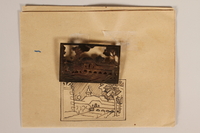
Pin with a cutout image of the Small Fortress gate at Terezin pinned to paper made by a camp inmate
Object
Copper metal brooch pinned to paper with a sketch of the pin preserved by Jiri Lauscher. The pin was made at Theresienstadt ghetto-labor camp and has a cutout design of the Small Fortress gate as seen from the east. Jiri was an inmate of Theresienstadt ghetto-labor camp from December 1942 - May 1945. His woodworking skill got him assigned to the camp technical department. Jiri was from Prague which was invaded in March 1939 by Germany. Jiri was fired from his job because he was Jewish. In September 1941, Heydrich, the SS chief of Reich security, became Reich Protector and soon there were almost daily deportations of Jews to concentration camps. In December 1942, Jiri, wife Irma, and daughter Michaela, 5, were sent to Theresienstadt. Jiri became part of a closeknit group of artists at the camp. Irma taught Jewish traditions in the secret classes held for children. Around late October 1944, Jiri was waiting for the transport train to Auschwitz, when an SS guard asked for men to repair a roof. Jiri volunteered and the train, one of the last transports to Auschwitz, left before the roof was finished. The camp was taken over by the Red Cross on May 2, 1945. The war ended when Germany surrendered May 7. Jiri and his family returned to Prague in June. Most of their relatives were killed in German concentration camps.
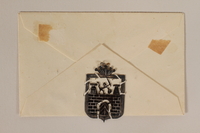
Cutout pendant of the Terezin coat of arms sewn to an envelope made by a former Jewish Czech inmate
Object
Silver metal pendant sewn to paper with a cut out of the Terezin coat of arms made by Jiri Lauscher, who was an inmate of Theresienstadt, the German name for Terezin, ghetto-labor camp in Czechoslovakia from December 1942 - May 1945. Pendants and pins similar to this were made in the camp's art and technical department. Jiri's woodworking skill got him assigned to the camp technical department. Jiri was from Prague which was invaded in March 1939 by Germany and made part of the Protectorate of Bohemia and Moravia. Under the Nazi regime, Jiri was fired from his job because he was Jewish. That September, Germany invaded neighboring Poland. In September 1941, Heydrich, the SS chief of Reich security, became Reich Protector and soon there were almost daily deportations of Jews to concentration camps. In July, Jiri's parents, Anna and Julius, were deported, and in September, his brother Frantisek. In December 1942, Jiri, Irma, and daughter Michaela, 5, were sent to Theresienstadt. Jiri became part of a closeknit group of artists at the camp. Irma taught Jewish traditions in the secret classes held for children. Around late October 1944, Jiri was waiting for the transport train to Auschwitz, when an SS guard asked for men to repair a roof. Jiri volunteered and the train left before the roof was finished. The camp was taken over by the Red Cross on May 2, 1945. The war ended when Germany surrendered May 7. Jiri and his family returned to Prague in June. Most of their relatives were killed in German concentration camps.



